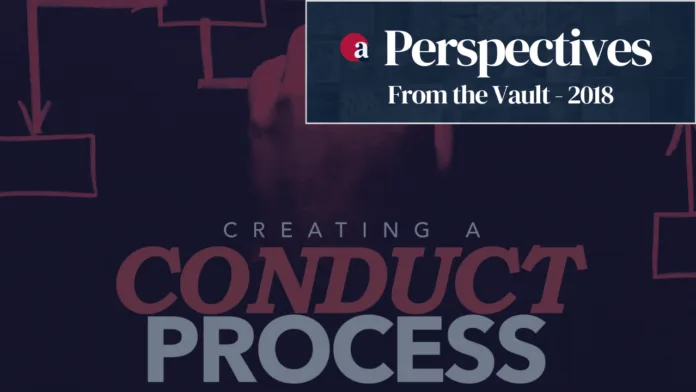This is a republication of an article first published in Perspectives in the second edition of 2018. The author provided the following reflection on the article.
Since your article was written six years ago, do you have any reflections on this article today?
The process of redesigning a community-wide conduct process for a fraternity and sorority community was an interesting and exciting endeavor. It was quite engaging to hear from all the stakeholders involved, from the chapter members, to the faculty, to the administrators who regularly deal with conduct on campus. During my remaining time on that campus (I’ve since changed jobs), we were able to hold several training sessions for students and identified several faculty members willing to serve in this capacity. It was, while significantly challenging at times, a successful implementation process.
The suggestion provided of “consider the policies before deciding on how to structure the board” is maybe more important today. Substantial changes to hazing legislation in several states, in concert with ever-evolving Title IX regulations, are just two examples of how this suggestion is more critical to the process of creating and educating a new board than at the time this article was written.
I also suggest adding training and education around proactive management of public relations for chapters (in collaboration with the university’s office of marketing and inter/national organizational personnel), as the higher level of scrutiny evolving from high-profile incidents raised the profile of fraternity and sorority life.
How do you think work around accountability has changed since you originally wrote this article?
The perception of accountability has changed. Work around this topic has evolved from what was more punitive to more empowering and multifaceted. The focus has seemingly shifted to an emphasis on student support and constructive outreach to address problems before they’re even problems. There is additional, proactive effort invested in researching and addressing the root causes of why individuals and/or groups act in the ways they do. The students I worked with demonstrated this behavior. Chapter members were always receptive to training and education that enabled them to help one another, be it how to report an issue of bias or assist a fellow member with their mental health and well-being. Students today seem more willing to share and seek assistance with those once-stigmatized issues, fostering a healthier and more inclusive environment for all members of their organization (JED, 2024).
Traditional norms around fraternity and sorority life are also changing. While this is chapter- or campus-specific, students today seemingly think and act more in line with “the individual” rather than “the collective.” For example, I often encountered members willing to address the individual causing the issues, in hopes of protecting the collective, which is quite a change from closing ranks and hoping for the best. Students today are far savvier; many know their future could be jeopardized by others in their organization when behavior doesn’t match organizational values. While students are interested and excited to take part in a hundred-plus year-old tradition on their campus, most are not willing to risk everything for what happens on Friday or Saturday nights.
Any additional relevant thoughts you may have…
There is no other experience in college where a student learns more about both themselves and how to work with others than fraternity or sorority membership. Think of the fraternity or sorority house as a “living laboratory” where 18–22-year-olds are responsible for a million-dollar physical plant and the lives of thirty (or more) tenants and their behaviors. Students are exposed to real-world experiences (e.g., paying bills, resolving conflicts, managing their time, making healthy life choices, building a network) with the added benefit of a safety net. When done “right,” fraternities and sororities provide an environment where members are both encouraged and expected to take responsibility for their own actions, support one another, and contribute to both the organization and their surrounding community, while preparing for their futures.
Starting an all fraternity/sorority conduct process is no easy feat. The concept of self-governance is as old as the fraternal movement itself; one that is at the heart of the fraternity experience (McCreary, blog post, May 2, 2014). So, after many years of failing to launch a way in which the students could successfully hold one another accountable under the helpful eye of administrators, we’ve finally landed on a way honoring the self-governance of our chapters, while at the same time recognizing a faculty governance structure that affects most, if not all, decisions made within the life of the campus.
Our university is home to approximately 2,100 undergraduates of which just over 500 are members of one of our eight fraternal organizations. The university is private and operates under what is commonly referred to as a shared governance structure, a “delicate balance between faculty and staff participation in the planning and decision-making processes” (Olson, 2009). That includes decision-making by a variety of faculty committees, including a student conduct board hearing and the student conduct hearing appeals processes. The general student conduct board for the university is comprised of a pool of six undergraduate students, six elected faculty (voted upon by the faculty’s senate), and a designee of the Office of the Vice President of Student Affairs and Dean of Students, who is vested with authority over student conduct by the university’s president (Student Handbook, 2017). In our case, the designee is the director of student conduct. The director is responsible for administering the student conduct hearing panel, including many of the administrative responsibilities and training that comes with convening a hearing panel. When a hearing panel is called, it consists of two student and two faculty representatives from that trained pool of individuals and the director of student conduct (Student Handbook, 2017).
Using our general student conduct process as a framework, we assembled a working group to look at how a process of addressing conduct and risk management issues and violations could be applied to our fraternity/sorority community. The working group included the IFC and Panhellenic presidents, the IFC and Panhellenic vice presidents responsible for risk management and administration, the IFC and Panhellenic advisor, and the director of student conduct, who was a wealth of information in terms of explaining and clarifying procedures. For an entire year, the working group looked at how the individual chapters addressed conduct; how previous iterations of the conduct process addressed issues; what issues we were most likely to adjudicate as a result of hosting an all-fraternity and all-sorority board; sample ideas for conduct procedures and processes from similar (and some not so similar) fraternity/sorority communities; and how the board should be comprised.
Our final iteration includes the following suggestions for your consideration, if your community is looking to begin or to revise a fraternity/sorority life specific conduct process.
- When looking for examples, campus culture matters. There are some amazing examples of the conduct process done well, but exact replication from one campus to the next is likely not to be successful. Consider contacting peer and aspirant fraternity/sorority communities with similar university demographics. It is instrumental to honor the specific context of your campus and chapters.
- Include faculty who are knowledgeable or well-versed in fraternity/sorority life. Including faculty who are not affiliated is a way to build advocacy for the fraternal experience on campus, but also pay special attention to those who were active members as undergraduates. We are fortunate to have several fraternity and sorority alumni, both from our university and from others, that know and “get” the fraternity experience to serve in this role. While it’s certainly not a requirement, and not an available option to all, it’s a starting point that can make the students involved in the conduct process feel as though their experience will be understood, not dismissed.
- Be thoughtful about how to train the undergraduate students and faculty members. We were intentional in training the students and faculty members of the board together, so they could not only get to know one another, but also so all involved heard the same information. Utilize the students from the governing councils responsible for this process in facilitating training material, especially regarding confidentiality. There’s something very powerful in having peer education around this topic.
- Consider the policies before deciding on how to structure the board. There are very specific instances where who is part of a hearing is important to keep in mind. One is addressing infractions by NPC sororities. To properly follow the NPC judicial procedures, we established a procedure utilizing the sorority members and faculty who are representatives to the fraternity and sorority conduct board if issues go beyond that of mediation. Our procedures address violations of NPC Unanimous Agreements, guidelines, and recruitment infractions, following the process and procedures as outlined in the current year Manual of Information (NPC, 2018).
- Consider the experience students bring to the conduct board. In our version, it was important that fraternity and sorority members had been active chapter members for a minimum of one year, including their new member semester. We believed this provided individuals enough time to experience fraternity or sorority life to make stronger, more educated decisions.
- Assess after each incident. Each time a conduct process occurs, take a look at the entire process from start to finish. See if the needs of all parties were met and ensure that the process was fair and as objective as was possible. This can be done by survey, observation, and focus group of all involved parties.
When enacted in tandem with educational risk management programming, proper training, and the work of the organizations’ national offices, a fraternity/sorority conduct process can be a powerful and helpful educational tool. It is our hope this process continues to enhance the learning laboratory that is the undergraduate fraternal experience.
References
The Jed Foundation (2024). Fraternities and Mental Health: Supporting Emotional Well-Being Among Members and Across Campus. https://jedfoundation.org/fraternities-mental-health-report
McCreary, G. (2014, May 2). Is self-governance dead? [Blog post]. Retrieved from http://doctorgentry.blogspot.com/2014/05/is-self-governance-dead.html
Olson, G. A. (2009, July 23). Exactly what is ‘shared governance’? The Chronicle of Higher Education. Retrieved from https://www.chronicle.com/article/Exactly-What-Is-Shared/47065
University of Mount Union (2017). Student handbook. Alliance, OH.
About the Author
 Katherine Carnell, PhD, is the Assistant Vice President for Student Engagement at Goucher College, where she oversees a staff responsible for campus activities, student organizations, new student engagement, and student government. She previously served as Director of Student Involvement & Leadership at her alma mater, the University of Mount Union, from 2006 – 2021. During that time, she oversaw fraternity and sorority life, student activities, and taught in the university’s minor in leadership studies. Carnell earned both a master’s and a doctorate in higher education administration and currently serves as managing editor of the Student Affairs on Campus Journal, a publication of TACUSPA.
Katherine Carnell, PhD, is the Assistant Vice President for Student Engagement at Goucher College, where she oversees a staff responsible for campus activities, student organizations, new student engagement, and student government. She previously served as Director of Student Involvement & Leadership at her alma mater, the University of Mount Union, from 2006 – 2021. During that time, she oversaw fraternity and sorority life, student activities, and taught in the university’s minor in leadership studies. Carnell earned both a master’s and a doctorate in higher education administration and currently serves as managing editor of the Student Affairs on Campus Journal, a publication of TACUSPA.




